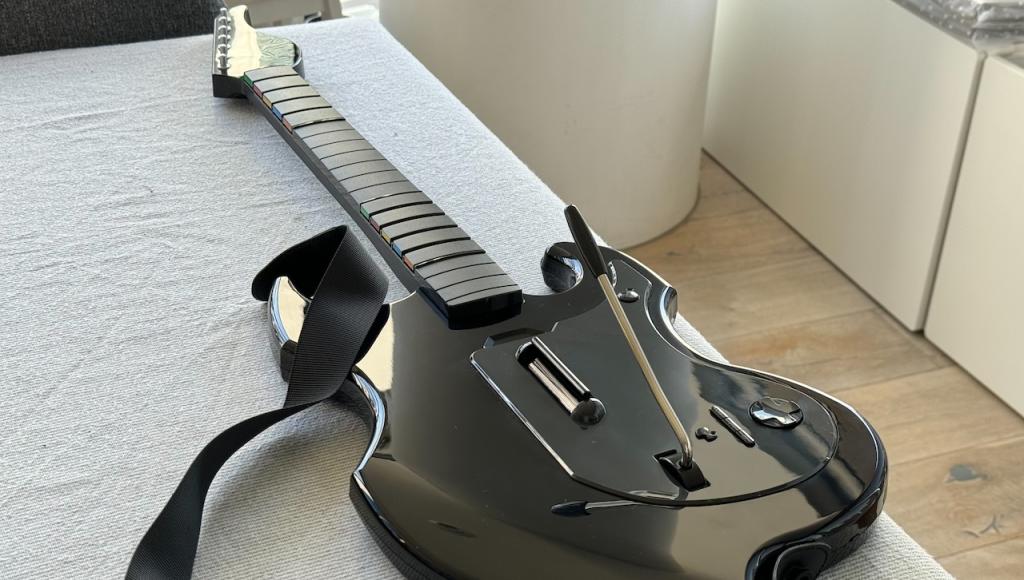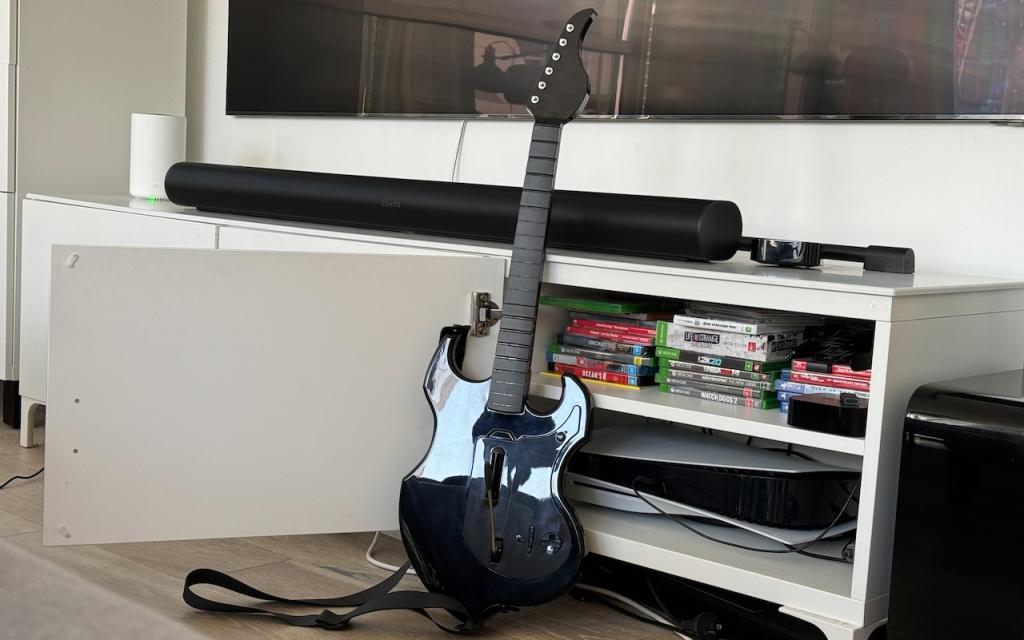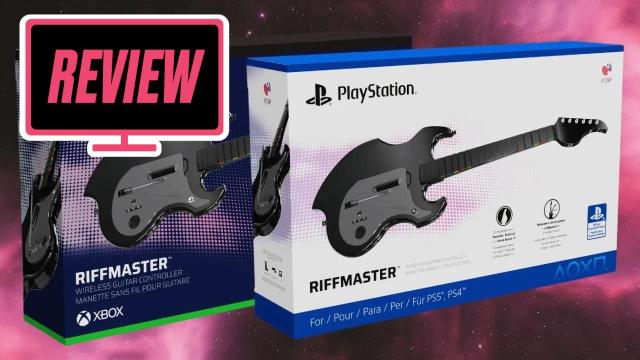The PDP Riffmaster guitar controller is here. Rock Band fans, we are so back.
The period between 2007 to 2015 was a golden age of novelty gaming accessories. There was a Tony Hawk game with a physical skateboard controller (it was bad). Most of us remember balancing on a Wii Fit board. There were lots of gun-shaped controllers, golf clubs, tennis racquets, etc. But no novelty plastic controller ever held more sway than the guitar. The popularity of Guitar Hero and Rock Band was so massive that it seemed as though these controllers could be found in every gaming home. So, you can imagine my nostalgic glee when the new PDP Riffmaster guitar controller was announced.
The PDP Riffmaster was designed in response to the launch of the Fortnite Festival game mode. Made by Harmonix, creators of both Guitar Hero and Rock Band, Fortnite Festival answers the question: “What if Rock Band was in Fortnite and the DLC songs were a lot more expensive?” Amusingly, Fortnite Festival is (currently) not even slightly compatible with the Riffmaster. Indeed, no part of Fortnite — none of its game modes, none of its menus — will recognise any inputs from the Riffmaster, which seems rather pointed. Compatibility is coming soon, however.
So, because I can’t yet use it to play the game it was designed for, I’ve spent the last week playing Rock Band 4 with the PDP Riffmaster and, mostly, it’s been great!
PDP Riffmaster Design

In the past, there were all kinds of licenced plastic guitar designs. Remember when they did The Beatles instruments? What a time. That golden age has passed now, and so we have whatever the hell this thing is.
The headstock and the top half of the body look like they were inspired by Ibanez guitars. But then, the bottom of the Riffmaster has the same vibe as when I try to draw a love heart, and nothing lines up properly. Or, you know, the Ibanez Stanley Signature.
The problem with trying to make a guitar controller not look like any copyrighted guitar designs is that guitars have been around for a long time, and all the good body shapes already exist. That means the only options you’re left with lead you to, well, this. I don’t mind it. It doesn’t look too bad to my eye, but I also know multiple people who absolutely hate this design.
Of course, what’s more important than the aesthetics is how it feels to play, and there I have mostly good news. The neck of the guitar feels perfectly proportioned, for my hand at least, and the neck buttons feel appropriately tactile. For those wanting to feel more like they’re doing a proper guitar solo, or for people whose arms aren’t long enough, there are smaller buttons closer to the body of the guitar. These are a bit narrower, but still feel good.
The whammy bar is also perfectly portioned—easy to grab yet unobtrusive. Plus, the addition of an analogue stick on the back of the guitar, where the neck meets the headstock, is genius. It makes it much easier to navigate through menus. However, it is also positioned exactly where I like to rest my thumb when I play, so there has been quite a period of adjustment.
However, the design is not all roses and dancing – there is no overdrive button. There are usually four ways to activate Overdrive (or whatever the bankable score multiplier is called in your rhythm game of choice): tilting the guitar, pressing Options or ‘left’ on the D-pad, or pressing a dedicated Overdrive button. The large, dedicated Overdrive button on older guitars was great because activating it via tilt while sitting is difficult, especially if you sit in a weird position. Here, the Options button and D-Pad are in such an out-of-the-way spot that an Overdrive button would have been the only way to activate the Star Meter without losing your streak. Overdrive activates just fine when you play standing up, but it’s very hit-and-miss sitting down, and most millennials just don’t have the knees to stand up and play these days.
It’s hard to compare it to my old Guitar Hero/Rock Band guitars with so many intervening years in the way. However, the Riffmaster feels exactly how I remember the plastic guitars feeling, with one key difference: The strum bar isn’t as tactile as it was on the old ones. That’s not a deal breaker, and in some ways, it makes playing on expert feel a little easier, but it is slightly less satisfying.
Other than that, it’s pretty good. It connects to the PlayStation with a USB-A dongle, and there is room behind the scratch plate to store it so it doesn’t get lost. The neck folds down for easier storage. All around, with the exception of overdrive, it’s what you want it to be.
OK, but is the PDP Riffmaster fun to play with?
Buckle up, kids. I’m about to tell you a tangentially related story: I don’t think it’s much of a secret that most people who review video games have specific games at which they are not incredibly good. We play so many different games, and at such a rate, that you don’t necessarily have the time to develop esports-level skills at games that require hundreds, if not thousands, of hours to fully master.
I spent the 2010s reviewing games for a newspaper, and while I perhaps shouldn’t generalise for others, the above absolutely reflects my experience. Except when it came to Rock Band and Guitar Hero – I was quite good at them. For years, my ex and I held Top 10 scores on the leaderboards for certain songs. We would spend an inordinate amount of free time trying to find a couple of extra points on those songs and secure that number-one slot. For a few days at launch, I had the number-one score on ‘The Con’ by Tegan and Sara in Rock Band 3.
I am perfectly fine at plenty of game genres, but in my late teens/early 20s, I was excellent at rhythm games. This was, perhaps, because music has always been extremely important to me. Maybe it’s because I’ve been playing the drums for over 20 years and keeping time is just an inherent part of that. I played some guitar in primary school and high school, but I was never good at it. I wouldn’t be able to play a song by ear, even if I could play from tabs. I’m not terrible at bass guitar, which always came a bit more naturally (rhythm section 4 eva).
In high school, whenever it was school holidays (or I’d been expelled and was between schools), I’d play drums for eight hours a day, over and above my regular practice time. However, I have always been extremely bad at Rock Band/Guitar Hero drums, because they were just wrong enough that they went against my muscle memory. Guitarists I knew at the time (including ones who had songs in rhythm games) were absolutely terrible at guitar in-game but could ace drums. Bass players were fine at their instrument in rhythm games, bucking the trend.
That is all a very long-winded way of saying that I have spent a lot of time around Rock Band guitars, and a lot of time thinking about what makes them good and how different skills translate to plastic instruments.
Picking up the Riffmaster suddenly brought me back to my childhood home, sitting on a red recliner chair with my ex, spending whole days trying to play through the full setlist of every song in all the games.
All the muscle memory and ghosts of conversations came back while playing. Alas, the skill did not.
Trying to get 95% on songs that I used to easily get 100% on felt like a proper challenge. I failed out of a song that I used to be competitive with. The memories come back in a flood, but the skills will require more coaxing.
Part of the problem is that if you don’t properly practice a skill for a decade, it will diminish somewhat. Even separated from slowing reflexes due to the inescapable horrors of aging, skill requires regular maintenance, or it fades like a couch left in the sunlight.
So, if you also used to really value your Guitar Hero skills and you pick up a Riffmaster, brace yourself for a rebuilding phase.
However, the fun is still there. Rock Band has not stopped being just a banger party game. It’s still the perfect title to get out when you feel like listening to music more actively but don’t feel like making your own.
I’ll update this review once Fortnite Festival is updated to support the Riffmaster because, let’s face it, while being able to revisit Rock Band 4 is good, that’s not why this controller exists.
(It’s worth noting that Rock Band 4 is $15 on the PlayStation store and is a completely worthwhile pickup, even if you are mostly buying the Riffmaster for Fortnite.)
Anyway, the play experience is great, even if you can’t immediately regain your 19-year-old reflexes and skills.
PDP Riffmaster verdict

I don’t think this controller should be priced at almost $200. That is very expensive for what this is, and that’s going to make it difficult for most people to justify. However, I can also understand why it is $200: it’s a big risk for a company like PDP to take. Previously, Rock Band instruments have not sold well. It is a very niche product, and it’s got to be significantly more complicated to manufacture and ship than a regular-sized controller.
That said, it’s still $200, and we’re currently living through (say it with me now) a cost-of-living crisis. So your desire to spend $200 on a guitar controller is entirely between you and whichever lender you currently owe money to.
For $200, I would have liked to see a slightly less flimsy and plasticky guitar – something closer to the wooden Logitech Guitar Hero guitars (I still have my orange one).
Price aside, the PDP Riffmaster guitar controller is the best guitar controller on the market for current-gen consoles. This is partially because it is the only current-gen guitar controller on the market and partially because it is quite good. If you want to go back to playing rhythm games as Harmonix intended, then this is the way to do it, and, for the most part, it’s absolutely glorious.
The age of novelty plastic controllers died off because people remembered that they had nowhere to store masses of plastic junk that were only good for playing one game, so I hope this doesn’t fully herald a new era. But I’m glad the guitars are back, this is what I’ve been hoping for for a decade. The Riffmaster might not be the exact current-gen guitar controller I dreamed of, and that price is difficult to stomach. Yet it is better than no guitar controller, and still very good.
The PDP Riffmaster will be available in the US in April and in Australia from the 14th of June. You can preorder it at EB Games.
Image: PDP, Kotaku Australia

Leave a Reply